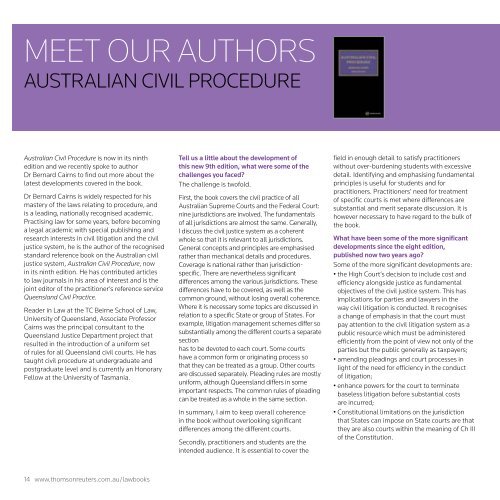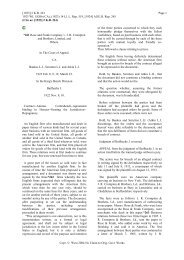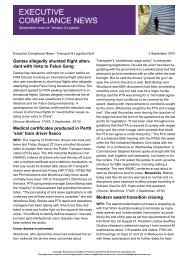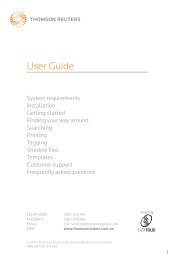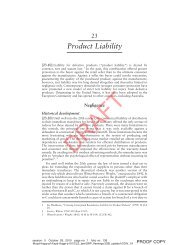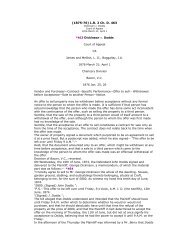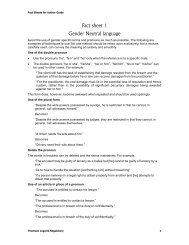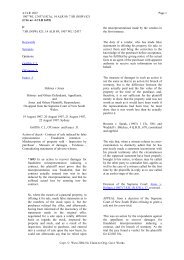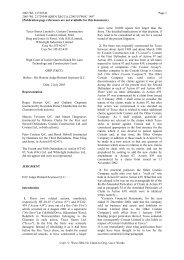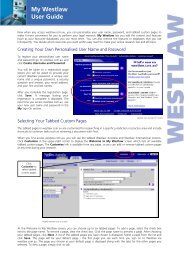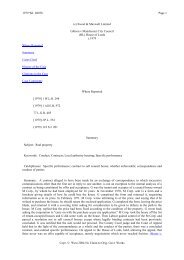DoWnloaD - Thomson Reuters
DoWnloaD - Thomson Reuters
DoWnloaD - Thomson Reuters
You also want an ePaper? Increase the reach of your titles
YUMPU automatically turns print PDFs into web optimized ePapers that Google loves.
meet our AUTHORS<br />
AUSTRALIAN CIVIL PROCEDURE<br />
Australian Civil Procedure is now in its ninth<br />
edition and we recently spoke to author<br />
Dr Bernard Cairns to find out more about the<br />
latest developments covered in the book.<br />
Dr Bernard Cairns is widely respected for his<br />
mastery of the laws relating to procedure, and<br />
is a leading, nationally recognised academic.<br />
Practising law for some years, before becoming<br />
a legal academic with special publishing and<br />
research interests in civil litigation and the civil<br />
justice system, he is the author of the recognised<br />
standard reference book on the Australian civil<br />
justice system, Australian Civil Procedure, now<br />
in its ninth edition. He has contributed articles<br />
to law journals in his area of interest and is the<br />
joint editor of the practitioner’s reference service<br />
Queensland Civil Practice.<br />
Reader in Law at the TC Beirne School of Law,<br />
University of Queensland, Associate Professor<br />
Cairns was the principal consultant to the<br />
Queensland Justice Department project that<br />
resulted in the introduction of a uniform set<br />
of rules for all Queensland civil courts. He has<br />
taught civil procedure at undergraduate and<br />
postgraduate level and is currently an Honorary<br />
Fellow at the University of Tasmania.<br />
Tell us a little about the development of<br />
this new 9th edition, what were some of the<br />
challenges you faced<br />
The challenge is twofold.<br />
First, the book covers the civil practice of all<br />
Australian Supreme Courts and the Federal Court:<br />
nine jurisdictions are involved. The fundamentals<br />
of all jurisdictions are almost the same. Generally,<br />
I discuss the civil justice system as a coherent<br />
whole so that it is relevant to all jurisdictions.<br />
General concepts and principles are emphasised<br />
rather than mechanical details and procedures.<br />
Coverage is national rather than jurisdictionspecific.<br />
There are nevertheless significant<br />
differences among the various jurisdictions. These<br />
differences have to be covered, as well as the<br />
common ground, without losing overall coherence.<br />
Where it is necessary some topics are discussed in<br />
relation to a specific State or group of States. For<br />
example, litigation management schemes differ so<br />
substantially among the different courts a separate<br />
section<br />
has to be devoted to each court. Some courts<br />
have a common form or originating process so<br />
that they can be treated as a group. Other courts<br />
are discussed separately. Pleading rules are mostly<br />
uniform, although Queensland differs in some<br />
important respects. The common rules of pleading<br />
can be treated as a whole in the same section.<br />
In summary, I aim to keep overall coherence<br />
in the book without overlooking significant<br />
differences among the different courts.<br />
Secondly, practitioners and students are the<br />
intended audience. It is essential to cover the<br />
field in enough detail to satisfy practitioners<br />
without over-burdening students with excessive<br />
detail. Identifying and emphasising fundamental<br />
principles is useful for students and for<br />
practitioners. Practitioners’ need for treatment<br />
of specific courts is met where differences are<br />
substantial and merit separate discussion. It is<br />
however necessary to have regard to the bulk of<br />
the book.<br />
What have been some of the more significant<br />
developments since the eight edition,<br />
published now two years ago<br />
Some of the more significant developments are:<br />
• the High Court’s decision to include cost and<br />
efficiency alongside justice as fundamental<br />
objectives of the civil justice system. This has<br />
implications for parties and lawyers in the<br />
way civil litigation is conducted. It recognises<br />
a change of emphasis in that the court must<br />
pay attention to the civil litigation system as a<br />
public resource which must be administered<br />
efficiently from the point of view not only of the<br />
parties but the public generally as taxpayers;<br />
• amending pleadings and court processes in<br />
light of the need for efficiency in the conduct<br />
of litigation;<br />
• enhance powers for the court to terminate<br />
baseless litigation before substantial costs<br />
are incurred;<br />
• Constitutional limitations on the jurisdiction<br />
that States can impose on State courts are that<br />
they are also courts within the meaning of Ch III<br />
of the Constitution.<br />
14 www.thomsonreuters.com.au/lawbooks


